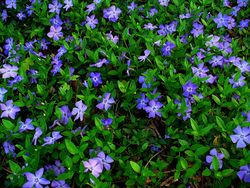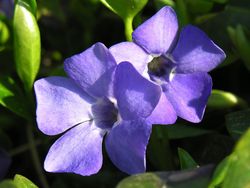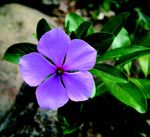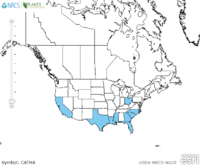Periwinkle
| Periwinkle |
|---|
| Scientific Classification |
|
| Species |
|
| Two beautiful periwinkles sitting in the sun |
The vinca or more commonly known as the periwinkle, Catharanthus roseus, is a plant that has been cultivated in the ancient Europe, China, and India. It was finally brought over to America in the late 1700’s. Today people use it to decorate their lawns, blood pressure medications, and chemotherapy cancer treatments.
In some religions such as Catholicism, the periwinkle is called the “virgin flowers”. It is commonly shown with Saint Marry. Marry usually wears blue clothes when the is with the plant and its blue flowers.
[3].
Body Design
The periwinkle or “vinca minor” is a small shrubby plant that can grow up to four inches in height. This plant can grow five feet in one direction and has a diameter of ten feet. [4]
The periwinkle is a short trailing plant with a long root system. It has short tube stems and has simple leaves. The leaves are opposite, elliptic, and have entire margins. The periwinkle’s five petal, star-shaped flower has colors can range from light blue to red-velvet including light blue, white, pink, and velvet. [5]
Life Cycle
The Periwinkle starts growing from a seed. It takes about seven to fourteen days for a Periwinkle to germinate and grow, but it may or may not have flowers the first year that it gets germinated. The Periwinkle's flowers blossom around mid-late spring and are pollinated then, but before they are pollinated they first grow as blue-purple or, sometimes, white flowers and are twisted into buds that are lengthened buds. Each of these buds have five petals attached to the base.[6]
The Periwinkle grows medium-fast depending on the conditions surrounding it.[7] As the Periwinkle grows, it trails the ground and when one of its leaf nodes touch the ground it roots into the soil. When there are a lot of leaf nodes they work as a trap, trapping moisture and nutrients which it later uses. The plant also grows 3 to 6 inches tall and about 18 inches wide.[8]
Ecology
Periwinkle, including vinca minor and vinca major, is originated from southern Europe, northwest Africa, and southwest Asia.[7] Periwinkle extensively spreads by harming other plant's habitat and covering all over the ground rapidly led to inhabiting throughout America. Periwinkle has thin trailing stems that are 1-2m(3.3-6.6ft)long but instead of growing straight tall, they stretch side to side and they do not grow higher than 70cm(27.5 in) which make them able to spread widely.[7]
Periwinkle was first introduced in North America in the 1700s for an ornamental use and it is still used today for ground covering plant.[9] However, unlike the purpose of use of the plant, periwinkle obstructs the growth and formation of other native plants. Also as they grow lower than other plants, periwinkle choke other plants and disturb their photosynthesis by covering flowers which leads to death. Periwinkle forms dense mats that cause suppression to native plants.[10] Extreme spreading affected Australia, Canada, New Zealand, and the United States, especially the coastal part of California.[7] Periwinkle does not likely grow in a dry area or the place where they face the sunlight directly.[11] On the other hand, it grows well in a wet soil and shaded places. It could be easily found in high (600ft) elevated soil in coastal counties, moist forest, and watercourses.
Invasive Species
Location and Method of Introduction
Environmental Impact
Once periwinkle settles on its favorite environment, it forms a dense cover which blocks the growth of other plant species. When periwinkle grows in an ornamental place, it covers all the crops that are in an active establishment because the periwinkle would not grow higher than any crops. As it kills other native plants, primary consumers that could take nutrition from the native plant cannot have the nutrition which they desire. Which means, they replace native plants that are beneficial to their habitat.[12]
Also, as periwinkle spread widely, they are threats to endangered and venerable plants. Periwinkle takes habitat from organisms which inhabit underground. Organisms that are living under the periwinkle cannot obtain water which is essential to all organisms because periwinkle covers the rain. Periwinkle usually lives near the site of original planting in shady areas in a secondary growth forest. A single offspring of periwinkle can easily spread clones and from widely matted areas that could cover woodland understory harms every native greenery plant that they encounter.
Control Methods
The Periwinkle leaves are water repellent. So if you want to put a herbicide on the Periwinkle, then put an oil based herbicide because it will get to the root and kill it. [13] Also, put the herbicide on the plant in the winter when all the other plants have died so they won't get killed and keep regrowing each year. The root can be many feet deep and that is the easy way to kill it, but there is another way. The other way is to dig it out. Manual removal is the best because it is the healthiest way for all the plants around the periwinkle. Start by digging a couple feet deep down around the infected area. Then start loosening the soil and this is the way you pull it out of the non-toxic route. Lastly, you should remember that to remove the periwinkle completely you have to remove all of its root and may need to dig a couple of extra feet down. [14]
Video
The following video shows how fast periwinkle grows and how it harms other native plants.
References
- ↑ Vinca L. periwinkle USDA Natural Resources Conservation Service. Web. Accessed November 13, 2017. Author Unknown
- ↑ Catharanthus Catharanthus - Wikispecies. Web. Accessed November 4, 2017.author unknown
- ↑ . [https://www.lakeforest.edu/academics/programs/environmental/courses/es203/vinca-minor-periwinkle-apocynaceae.php Vinca minor (Periwinkle) Apocynaceae]
- ↑ ketchum, dan . Fun Facts About the Vinca Vine. Web. .
- ↑ foundation, keystone. Image of Catharanthus roseus © India Biodiversity Portal. Web. 2013-09-13 .
- ↑ Periwinkle's Life Cycle Home Guides | SF Gate. Web. Accessed November 4, 2017.author unknown.
- ↑ 7.0 7.1 7.2 7.3 Vinca Wikipedia. Web. Published November 9, 2017. author unknown.
- ↑ How to Grow Periwinkle (Vinca) Gardening Channel. Web. Published February 12, 2014.author unknown.
- ↑ Swearingen, J., C. Bargeron Vinca minor Invasive Plant Atlas. Web.October 22, 2015.
- ↑ Vinca minorInvasive Species Council of BC. Web. Date, Author Unknown.
- ↑ Vinca minor Cal-IPC. Web. Accessed on Jan 5, 2018. author unknown.
- ↑ bhavya ab Invasive species: Periwinkles Vinca minor. Prezi. Web. last modified. November 24, 2014.
- ↑ Adam, Judith. Getting periwinkle under control Garden Making. Web. June 17, 2016.
- ↑ Grant, Bonnie. Periwinkle Weed Control – How To Remove Periwinkle Ground Cover Gardening Know How. Web. Published June 08, 2016.





